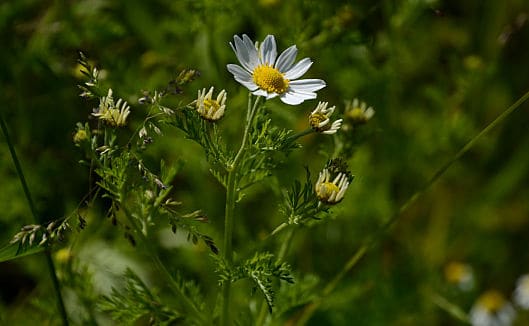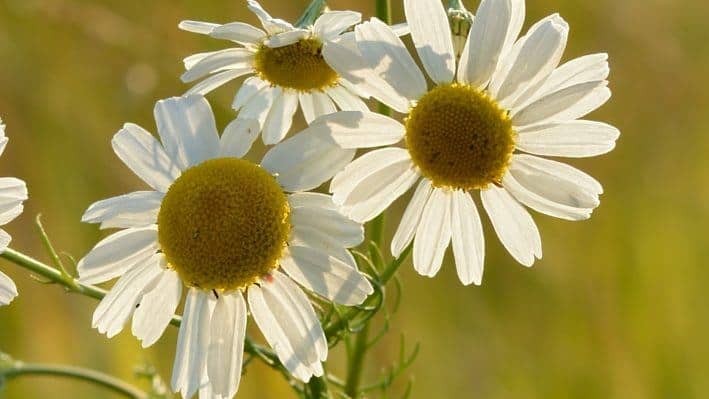Botanical Name: chamomilla, matricaria recutita, Chamomilla recutita.
Other Common Names: Mayweed, scented mayweed, pinheads, pineapple weed, German-hundskamille.
Habitat: This annual herb is originally from Europe but has become naturalized to most continents. It can be found growing along fences and paths in well-lit areas with well-drained, light soil.
Plant Description: The stem of the chamomile plant is erect and hollow. It is a small plant, growing to a height of 8 to 16 inches.
The flowers are small (about 1 inch across) and daisy-like with a white-collar around a cone-shaped, yellow center. The leaves are light green and feathery with a bipinnate pattern. The entire plant has a sweet, pineapple scent.
Plant Parts Used: The entire above ground portion of the plant can be used. The flowers are edible and can be used raw to top salads.
The chamomile flowers are also often dried and used in tea or added to the bath. They may also be pressed for their oil.
The leaves are dried and used in aromatherapy and other herbal medicines.

Therapeutic Uses, Benefits and Claims of Chamomile
Chamomile is used for its anti-inflammatory, antibacterial, antispasmodic and sedative properties.
It is also used internally to treat spasms and inflammation of the digestive tract.
In ancient Anglo-Saxon days, the chamomile flowers were chewed to relieve toothaches, which coincides with today’s use as a mouth rinse for sore gums and as an herbal treatment for gingivitis and inflammations of the oral cavity.
Chamomile is often used to treat nervous disorders such as insomnia, anxiety and nervous tension.
A salve or compress made from chamomile can be used to help treat wounds, burns, cold sores, canker sores, pinkeye, dermatitis and other skin irritations, due to its antibacterial and anti-inflammatory properties.
Chamomiles antispasmodic effects make it useful in treating spasms and cramping, including menstrual cramps.
Chamomile is used to make soothing teas and as an additive to bath water for a relaxing soak.
It is often added to cosmetics as an anti-allergen.
The anti-inflammatory properties of this medicinal herb make it a good choice for sufferers of rheumatoid arthritis, osteoarthritis or other painful swelling disorders.
This herb is safe for use in children and may help with children’s problems that have a nervous component.
It has also been used as a herbal remedy for heartburn, morning sickness, motion sickness, chickenpox, diaper rash, irritable bowel syndrome (IBS) and colic.
Dosage and Administration
Chamomile can be used as a tea by steeping the crushed flowers (2-3 teaspoonfuls) in a cup of boiling water for 5 to 10 minutes and then draining.
Adding 1 cup of the dried petals in a linen bag to hot bath water will make a relaxing bath.
The oil can be used on the skin as treatment for skin conditions such as eczema.
The creams and gels made from the oils can be used externally throughout the day. A typical dosage of 10 to 15 grams (about 3 to 5 tablespoonfuls) daily shows promise.
Potential Side Effects of Chamomile
Chamomile has been shown to cause allergic reactions to people who have allergies to other members of this plant family (including arnica, artemisia, feverfew, tansy and yarrow.)
People with hay fever or asthma should be cautious when beginning use of chamomile, as it has been found to aggravate these conditions in some people.
Contact allergies have been found in rare cases as well
People on blood-thinners such as Coumadin or Warfarin should consult their physician before using chamomile because it may enhance the effects of the medications. Alcohol use should be limited due to the sedative effect.
The use of chamomile while on prescription sedatives (such as Ativan, Valium, and Xanax) must be monitored as well.
Thordur Sturluson
Latest posts by Thordur Sturluson (see all)
- What is the Difference Between Hemp and Marijuana? - June 3, 2019


Great post! Chamomile is definitely on my list of future must haves. When it comes to store-bought tea, I generally stick to green tea. But if I could make myself a bit of tea from my own garden, that would be a treat.